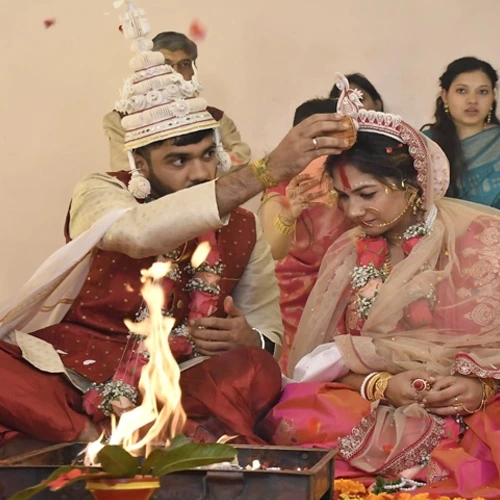
It begins with a grandmother's humming in the kitchen, a father hiding his tears behind the newspaper, cousins running around with sindoor-covered palms, and a mother carefully folding her daughter's laal Benarasi. At its heart, a Bengali wedding is an emotional homecoming, a bridge between the past and the future.
At Sumangalam, we believe a wedding should not feel like a hurried performance. It should feel like a story unfolding gently—a story where love, laughter, family, and faith come together.
We ensure that the ceremony speaks to everyone present—not just through chants, but through translation, explanation, and emotion. We take time to narrate the 'why' behind every moment, so the couple and their families feel connected, not just included.
We are a collective of lady priests in Kolkata who approach each wedding with empathy, clarity, and creativity. Our ceremonies are deeply rooted in Vedic tradition, yet free from outdated customs like Kanyadaan, which often contradict the spirit of equality.
Instead, we offer alternative rituals—ones that honour both partners equally, celebrate choice, and uphold dignity. Whether it's a same-gotra union or an interfaith one, we welcome and guide all with the same respect and care.
We've seen hesitant grandparents become teary-eyed believers. We've seen grooms express emotion they never thought they would. And we've seen couples finally feel seen and respected—not just as part of a ceremony, but as the very soul of it.
Gone are the days when the couple's voice was the least heard in their own wedding. At Sumangalam, we listen to your story—how you met, what you value, the memories you want to carry into marriage—and then weave those into the fabric of the ceremony.
We often include:
It's not just about getting married—it's about getting emotionally anchored in your new journey.
Many couples and families approach us with worries:
The answer is always a warm yes. At Sumangalam, we create safe spiritual spaces where there is no judgment—only joy, respect, and personal resonance. We help families overcome confusion and find peace with their choices.
Our name—Sumangalam—means "auspiciousness, beauty, and harmony." That's what we bring into every wedding. As lady purohits in West Bengal, we are not just officiants—we are keepers of your emotion, curators of your experience, and gentle guides on your sacred day.
We don't just perform a ceremony—we co-create it with you, ensuring that it feels authentic to who you are and what you believe in.
If you're dreaming of a wedding where meaning triumphs over show, where you feel emotionally held, and where the ceremony tells your story—reach out to us.
Let's make your marriage not just a ritual, but a soulful celebration that stays with you forever. Let's talk. Let's connect. Let's create magic together.
© 2025 Sumangalam . All Rights Reserved | Design & Developed by DITS